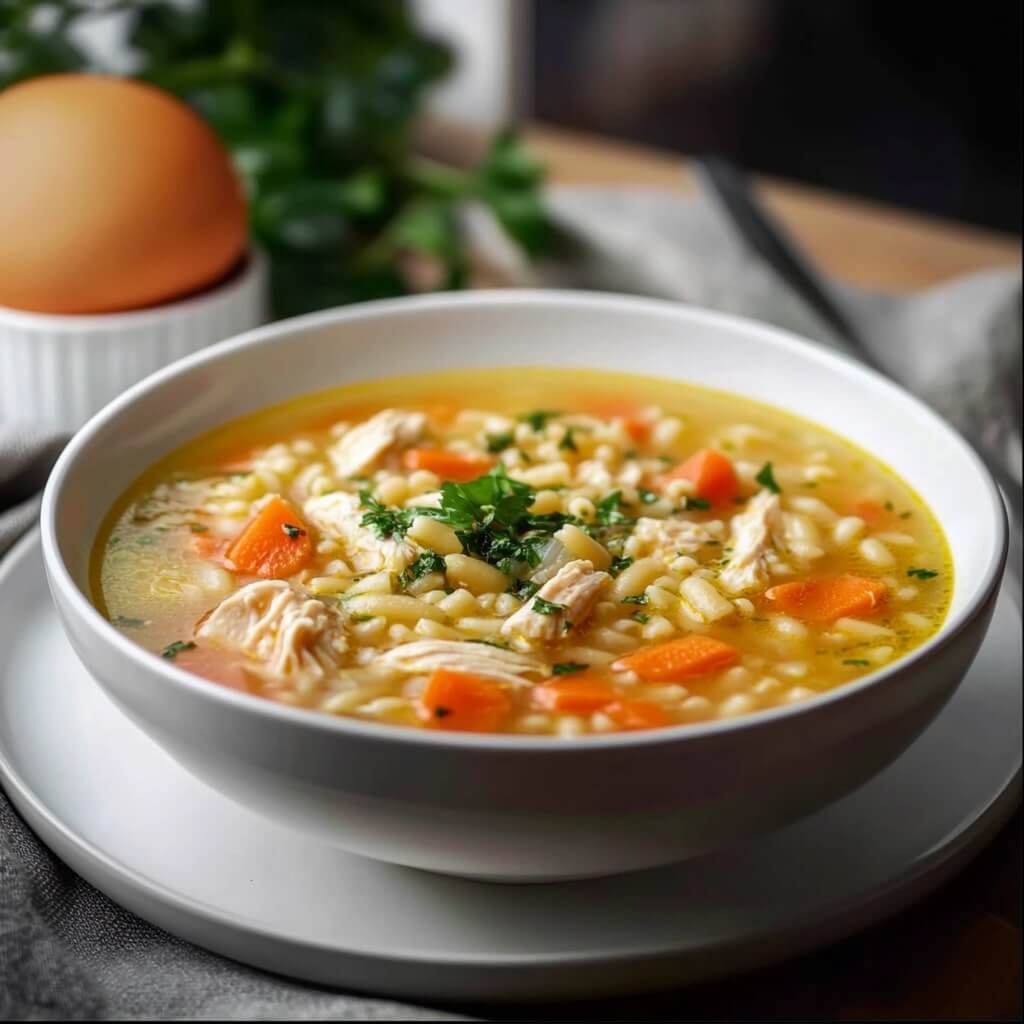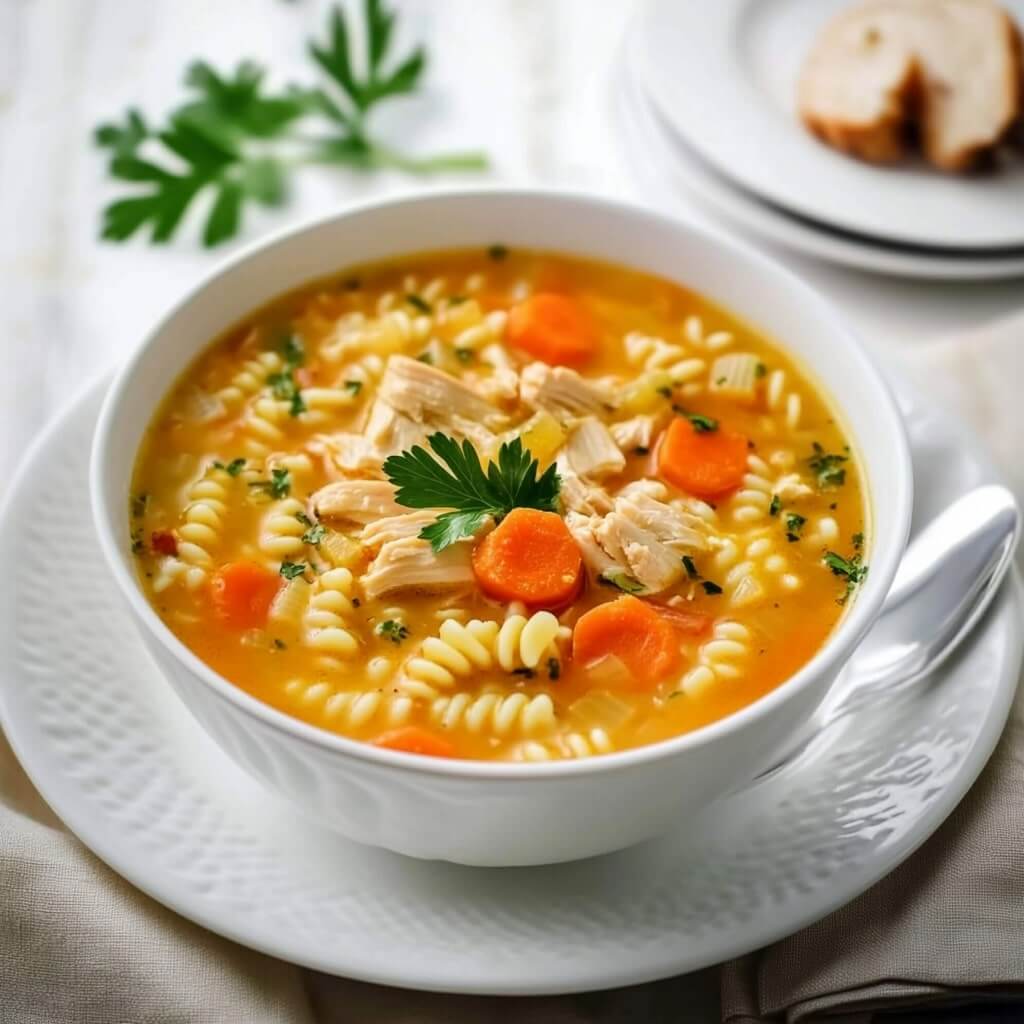Chicken Pastina Soup is a comforting, heartwarming dish that brings together a medley of flavors, nutrients, and warmth in every spoonful. A quintessential Italian favorite, this soup is a perfect choice for busy weeknights or chilly days when you crave a meal that is both satisfying and easy to prepare. Whether you’re cooking for the family or looking for a soul-soothing bowl to enjoy by yourself, this recipe will quickly become a go-to.
What is Chicken Pastina Soup?
At its core, Chicken Pastina Soup is an Italian-style chicken soup, but it’s distinguished by its use of pastina, the tiniest pasta available, which adds texture and heartiness to the dish. Pastina means “little pasta” in Italian, and it’s often the first pasta children are introduced to in Italy. The soup combines small pasta, shredded chicken breasts, aromatic vegetables like carrots, celery, and onions, and a flavorful chicken stock base. This combination creates a rich and flavorful broth that is ideal for warming you up on a cold day.
Why is Chicken Pastina Soup a Classic?
Chicken Pastina Soup is more than just a simple dish—it’s steeped in tradition and memories. This soup is often associated with comfort and healing, especially for those feeling under the weather. In Italy, it’s fondly known as “Italian Penicillin” because it’s believed to be the ultimate cure for a cold or the flu. Not only is it delicious, but it’s a meal that brings a sense of familiarity, like being wrapped in a cozy blanket.
In this recipe, we’ll explore a quick and simple way to make this soup, cutting down on time without compromising on the authentic flavors. We’ll also highlight some variations and tips that can elevate your chicken pasta soup, making it even more delightful.

Ingredients You’ll Need
To make chicken pasta soup, you’ll need some basic ingredients that you might already have in your pantry. Here’s a simple list to gather everything for this hearty meal:
Key Ingredients
- 2 tablespoons olive oil
- 2 pounds boneless, skinless chicken breasts
- ¼ teaspoon garlic powder
- ¼ teaspoon ground black pepper (divided)
- ⅛ teaspoon salt
- ½ medium yellow onion (or white, red)
- 3 medium celery stalks
- 2 large carrots
- 6 cups chicken stock (or homemade stock if available)
- 3 cups water
- ½ pound pastina (Acini di pepe or Stelline pasta)
- ⅓ cup grated Parmesan cheese (plus extra for serving)
What Makes the Soup Stand Out?
Unlike regular chicken noodle soups that use long pasta, Chicken Pastina Soup incorporates pasta, making it ideal for those who enjoy smaller, bite-sized pasta. The pasta, once cooked, absorbs the broth and becomes a comforting part of the soup, blending perfectly with the vegetables and shredded chicken.
Tips to Perfect Chicken Pastina Soup
Here are a few pro tips for enhancing your Chicken Pastina Soup:
- Use homemade stock if possible for a richer, fuller flavor.
- Sear your chicken rather than boiling it. This step adds depth to the flavor and ensures the chicken is perfectly tender when shredded.
- Don’t skip the veggies; the sautéed carrots, celery, and onion provide essential flavors that balance the dish.

Step-by-Step Guide to Making Chicken Pastina Soup
Now that you have your ingredients, it’s time to dive into the cooking process. The following instructions will guide you through making chicken pasta soup, step by step.
Step 1: Searing the Chicken
Start by heating the olive oil in a large pot over medium heat. Once the oil is sizzling, pat the chicken breasts dry with a paper towel and add them to the pot. Season with garlic powder, pepper, and salt. Let the chicken sear for about 5 minutes on one side until golden brown. Flip the chicken over and pour in one cup of chicken stock. Cover the pot and let the chicken simmer gently for 7 minutes, or until cooked through.
Tip: Searing the chicken adds a delicious flavor to the base of the soup, setting the tone for the rest of the ingredients.
Step 2: Preparing the Vegetables
While the chicken is simmering, it’s time to prepare the vegetables. Peel and chop the onion, and dice the carrots and celery. The size of the chop will affect the texture of the soup, so aim for evenly sized pieces. Add the chopped vegetables to the pot once the chicken is removed and set aside. Stir occasionally, sautéing until the carrots and celery are softened, which may take up to 15 minutes. Avoid rushing this step; soft veggies will create a smoother, more flavorful soup.
Tip: If the vegetables begin to stick to the pot, you can add a little more stock or water to prevent burning.
Step 3: Shredding the Chicken
Once the chicken has simmered, remove it from the pot and set it aside to cool for a few minutes. Once cooled, shred the chicken using either two forks or a stand mixer with a paddle attachment on low speed. This method ensures the chicken stays tender and evenly shredded, making it easier to incorporate into the soup later.
Tip: Shredding the chicken while the vegetables cook helps save time and ensures the chicken is added at the perfect moment.
Step 4: Bringing It All Together
With the vegetables now softened, add the remaining chicken stock and water to the pot. Stir in the pepper and bring everything to a boil. Once boiling, add the pasta pasta to the pot. Lower the heat slightly and let it cook for about 10 minutes, or until the pasta reaches an al dente texture.
Tip: Keep an eye on the pasta as it cooks because pasta absorbs the broth quickly. Serve it as soon as the pasta is ready to prevent it from becoming mushy.
Step 5: Adding Chicken and Parmesan
Once the pasta is cooked, stir in the shredded chicken and grated Parmesan cheese. Let everything simmer together for another 2 minutes to heat through and allow the flavors to meld.
Tip: The Parmesan not only adds richness but also enhances the soup’s savory depth.

Tips for the Perfect Chicken Pastina Soup
Creating the perfect Chicken Pastina Soup doesn’t require any complicated techniques, but a few tips and tricks can help take it from good to great. Let’s explore some pro tips for making this dish even more delicious.
1. Don’t Rush the Searing Process
The first step in this recipe is searing the chicken, and it’s crucial for adding flavor. Searing the chicken helps lock in juices, creating a golden brown crust that contributes to the richness of the broth. Don’t rush this process – let the chicken sear on each side until it’s golden before moving on to the next step.
2. Season as You Go
Seasoning throughout the cooking process is key to building layers of flavor. Don’t just rely on the stock to flavor the soup. Make sure to season the chicken as it cooks and adjust the salt and pepper levels as you add ingredients like the stock, vegetables, and pasta. Taste the soup before serving to make sure the seasoning is just right.
3. Pay Attention to Pasta Cooking Time
Pastina cooks quickly, so it’s important to watch it closely. If you leave it in the broth for too long, it may absorb too much liquid and become mushy. Once the pasta is al dente, remove it from the heat to prevent overcooking. If you have leftovers, store the pasta separately from the broth to keep it from becoming too soft when reheated.
4. Add a Little Extra Cheese
While Parmesan adds a nice touch of flavor, don’t hesitate to add a bit more if you love cheesy soups. You can also experiment with other cheeses, like Pecorino Romano, for a sharper flavor. A sprinkle of grated cheese on top of each serving will add richness and depth.
Recipe Variations and Customizations
Although this Chicken Pastina Soup recipe is delicious as-is, you can always tweak it to your liking. Here are some variations to consider:
- Using Rotisserie Chicken: If you’re short on time, shredded rotisserie chicken is a great alternative to cooking your own chicken. Just be mindful of the salt content in store-bought chicken and adjust the seasoning as needed.
- Boneless chicken thighs: For a richer, juicier flavor, consider substituting boneless chicken thighs for the breasts. You may need to adjust the cooking time since thighs cook a little faster than breasts.
- Herb Add-ins: Fresh herbs like thyme, parsley, or rosemary can be added during the cooking process to enhance the fragrance and flavor profile of your soup.
- Vegetable Variations: Feel free to swap or add other vegetables like peas, spinach, or zucchini to change up the texture and nutritional value of the soup.
Storing and Reheating Leftovers
Chicken Pastina Soup makes great leftovers, but there are a few things to keep in mind to preserve its quality:
- Storing the Soup: Store the soup in an airtight container in the refrigerator for up to 4 days. However, be sure to separate the pasta from the broth if you’re planning on storing leftovers to prevent the pasta from becoming too mushy.
- Reheating: When reheating, add some extra broth or stock to restore the soup’s consistency, as pastina will continue to absorb liquid over time.
FAQs On Chicken Pastina Soup
What’s in Chicken Pastina Soup?
Chicken Pastina Soup is made with simple, wholesome ingredients. The main components include boneless, skinless chicken breasts that are shredded for tenderness, small pastina pasta (such as acini di pepe or stelline), and a blend of aromatic vegetables like onions, carrots, and celery. The soup is cooked in a flavorful base made from chicken stock and water, which is seasoned with salt, pepper, and garlic powder. Finally, grated Parmesan cheese is stirred in to add richness and flavor.
What is so special about pastina?
Pastina is a type of very small pasta, often used in Italian cooking for soups. What makes pastina special is its tiny size, which allows it to absorb the flavors of the broth while adding a light, comforting texture to the soup. It is especially popular in Italian households, often served to babies or elderly individuals because it’s easy to eat and digest. The small size of pastina also allows it to cook quickly, making it a great option for fast and satisfying meals.
What does pastina soup taste like?
Pastina soup has a rich, savory taste thanks to its broth, shredded chicken, and vegetables. The pastina pasta absorbs the flavors of the broth, creating a deliciously comforting experience with every bite. The soup tastes hearty but not too heavy, with a perfect balance of tender chicken, tender vegetables, and delicate pasta. It’s often described as a gentle, soul-soothing meal that feels both nourishing and satisfying, making it an ideal comfort food.
Can I add more vegetables to Chicken Pastina Soup?
Yes! Chicken Pastina Soup is very versatile, and you can easily add more vegetables to enhance both the flavor and nutritional value. Some great additions include spinach, peas, zucchini, or even a handful of kale. These vegetables will complement the existing flavors and provide extra vitamins and fiber, making the soup even more wholesome and hearty.
Can I make Chicken Pastina Soup without chicken?
While chicken is the key protein in Chicken Pastina Soup, you can make a vegetarian version by omitting the chicken and using vegetable broth instead of chicken stock. You could also add plant-based proteins, such as tofu or beans, to ensure the soup remains filling and nutritious. The flavor will still be delicious and comforting, with the vegetables and pastina providing plenty of taste and texture.

Recipe Card: Chicken Pastina Soup
Ingredients
- 2 tablespoons olive oil
- 2 pounds boneless, skinless chicken breasts
- ¼ teaspoon garlic powder
- ¼ teaspoon ground black pepper (divided)
- ⅛ teaspoon salt
- ½ medium yellow onion (or white, red)
- 3 medium celery stalks
- 2 large carrots
- 6 cups chicken stock (1 ½ quarts)
- 3 cups water
- ½ pound pastina (Acini di pepe or Stelline)
- ⅓ cup grated Parmesan cheese (plus extra for serving)
Instructions
-
Sear the Chicken:
Heat olive oil in a large pot over medium heat until sizzling. Pat the chicken breasts dry and season with garlic powder, black pepper, and salt. Add the chicken to the pot and sear for 5 minutes on each side until golden brown. Pour 1 cup of chicken stock over the chicken, cover the pot, and simmer for 7 minutes. Remove the chicken and set aside to cool. Shred the chicken once it’s cool enough to handle. -
Cook the Vegetables:
In the same pot, add the chopped onion, celery, and carrots. Sauté over medium-high heat for about 10-15 minutes until the vegetables are soft. Add extra stock if needed to prevent the veggies from burning. -
Simmer the Soup:
Once the vegetables are tender, add the remaining chicken stock and water to the pot. Stir in the black pepper and bring to a boil. -
Cook the Pasta:
Add the pastina to the boiling soup. Lower the heat slightly and cook for about 10 minutes until the pasta is al dente. -
Finish the Soup:
Stir in the shredded chicken and Parmesan cheese. Let the soup simmer for another 2 minutes until everything is heated through. Taste and adjust the seasoning if needed. -
Serve:
Serve the soup hot, topped with extra grated Parmesan if desired.
Notes
- If you’re in a hurry, you can use shredded rotisserie chicken instead of cooking your own. Add it after the vegetables have softened.
- If you prefer a richer flavor, use homemade chicken stock.
- Store leftovers in separate containers – keep the pasta and broth in different containers to avoid the pasta absorbing too much liquid.
- You can also freeze this soup, but store the broth and pasta separately for the best results.
Nutritional Facts (per serving)
- Calories: 353 kcal
- Carbohydrates: 30g
- Protein: 34g
- Fat: 10g
- Saturated Fat: 2g
- Cholesterol: 82mg
- Sodium: 506mg
- Potassium: 673mg
- Fiber: 2g
- Sugar: 5g
- Vitamin A: 2624 IU
- Vitamin C: 3mg
- Calcium: 67mg
- Iron: 2mg
